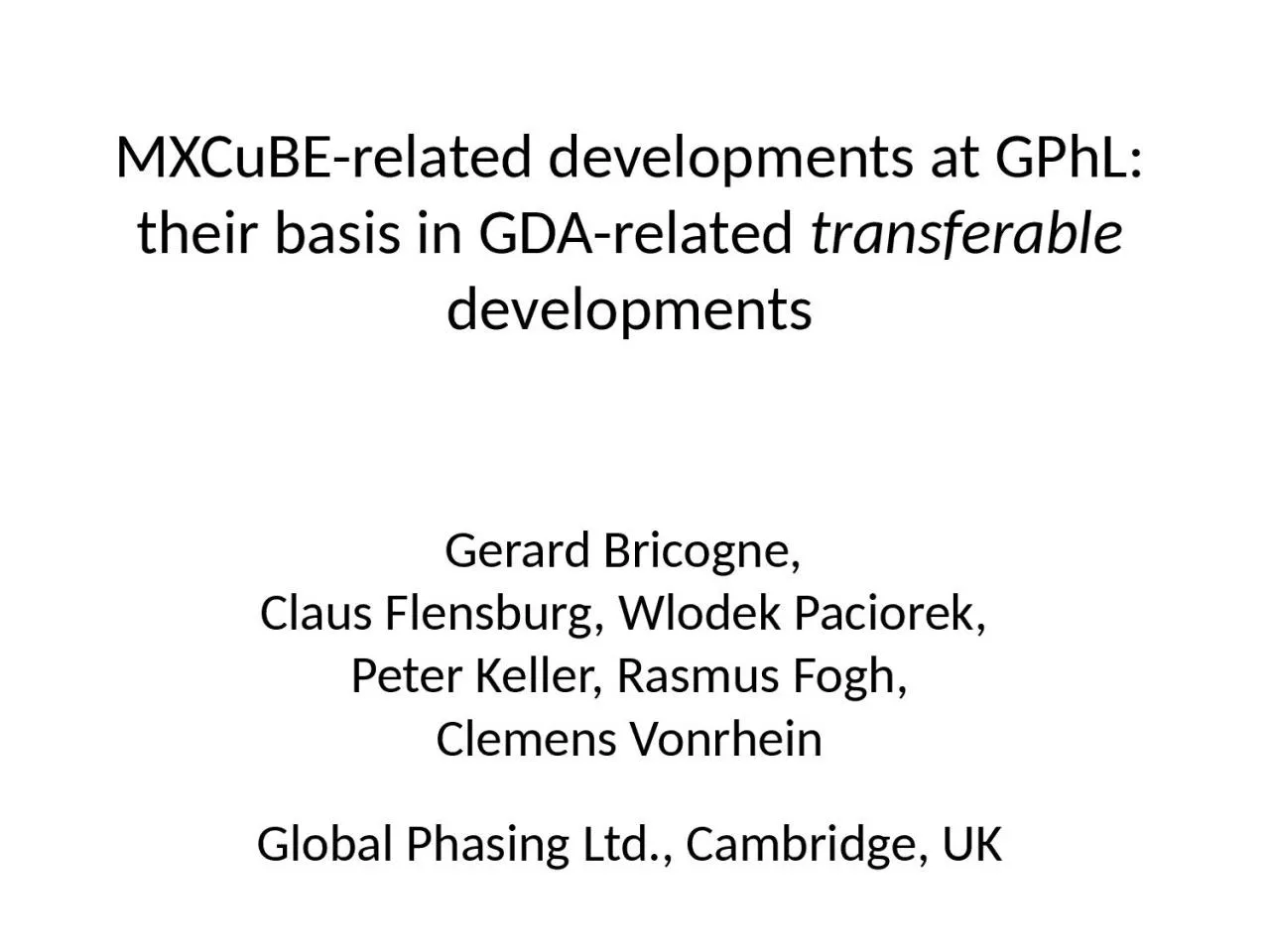

GPhL their basis in GDArelated transferable developments Gerard Bricogne Claus Flensburg Wlodek Paciorek Peter Keller Rasmus Fogh Clemens Vonrhein Global Phasing Ltd Cambridge UK ID: 1030477
Download Presentation The PPT/PDF document "MXCuBE -related developments at" is the property of its rightful owner. Permission is granted to download and print the materials on this web site for personal, non-commercial use only, and to display it on your personal computer provided you do not modify the materials and that you retain all copyright notices contained in the materials. By downloading content from our website, you accept the terms of this agreement.
1. MXCuBE-related developments at GPhL:their basis in GDA-related transferable developmentsGerard Bricogne, Claus Flensburg, Wlodek Paciorek, Peter Keller, Rasmus Fogh,Clemens VonrheinGlobal Phasing Ltd., Cambridge, UK
2. Introducing Transferable Expertise into Automated Data CollectionThe ever-increasing speed of MX beamline instrumentation is leading to ever-stronger emphasis being placed on brevity of execution as the main design goal for data collection protocols, often to the exclusion of other criteria that would aim at achieving higher data quality. This can be counter-productive, especially, but not only, for phasing experiments.Global Phasing, among others, has been interested in bucking that trend by creating combined capabilities for the fast design of optimal strategies and the direct supervision of their execution on an actual beamline. Our approach has been to aim for a full "third-party design and control" capability rather than for separate add-on programs that would need to be invoked by local software on each specific beamline or group of beamlines running under the BCS.To make this capability as transferable as possible across the broad diversity of beamline instruments and BCSs, finding the correct level of abstraction for all the components and processes involved is of paramount importance.
3. An unlikely opportunity to “push the frontiers”: the Diamond I23 long-wavelength beamline (Armin Wagner)In vacuo operationWavelengths 1.5-4.5A and perhaps beyondHalf-cylindrical Pilatus 12M detectorFull kappa goniometer
4. The ATC Kappa goniometer
5. S-SAD in C2: sweep 1 (k=0,f=0)
6. S-SAD in C2: sweep 2 (k=-10,f=70)
7. S-SAD in C2: sweeps 1 and 2 merged
8. Software requirementsDesign of multi-orientation strategies to achieve completeness, under constraints / restraints fromcollision avoidanceshadowing anticipation and mitigationExpert use of an "inverse-kappa" goniostat need to anticipate recentring translations required when changing orientationInterleaving capabilities to improve the signal/noise ratio of the phasing signal(s)alignment of 2-fold axes or inverse-beam technique for anomalous signalwavelength interleaving for dispersive signal
9. (a) Traditional k system: a 3D centring stage is located after the f motor and places the sample at the centre of the goniometer;(b) Inverse k system: a 2D centring stage is located between the and k motors and places the sample on the axis.
10. Any change of orientation requires a re-centring translation
11. Collision maps (calculated by WP from data by Vinay Grama) underline the current importance of predictive recentringRecentering modeData collection mode
12. Translational Calibration (TC) WorkflowCollect all TC measurementsStart TC workflowUpdate beamline configMessagebusGDAOperatorTranscalReCenorientation inTC designprevious TCparameterspredictedrecentringtranslationupdated TCparameterspreviousbeamlineconfiglist of orientations &recentring translationscollision map *with*OAV & backlightTC design(list of orientations)updatedbeamlineconfigactivityprogramworkflowdatai/okeyNote: use a restricted TC design to get rough TC parameters, then use ReCento pre-calculate recentring translations for a finer TC design to eliminate the need for zooming in/out
13. Translational Calibration updateTwo-stage procedure works very wellMuch better consistency between TC measurements once thermal dilation and contraction effects have subsidedSoC reduction by “active compensation” suspect for high Kappa values – needs revisiting
14. Calculate geometric strategy: detailactivityprogramworkflowdatai/okeyCalculate geometric strategystratcalReCenCheck centringcurrent RCparameterscurrent TCparameterspredictedrecentringtranslationproposedorientationin strategycollision mapinternal callcheckrangeMessagebus
15. Rotational Calibration (RC) WorkflowCollect all RC sweepsStart RC workflowUpdate beamline configMessagebusGDAXDS COLSPOTXCalibraconsolidatedspot listrough RCparametersrefined RCparameterspreviousbeamlineconfigimages forall sweepscollision map *without*OAV & backlightRC design 1(list of sweeps)updatedbeamlineconfigactivityprogramworkflowdatai/okeyNote 1: for orientations in RC design, use current TC parameters & ReCento pre-calculate recentring translations
16. Rotational Calibration updateOld results (3 October 2016) xc-23-33.pngNew data collection (27 November 2017)Prior TC and Recen enabledUnattended collection of 22 sweeps, with automated recentring after each change of orientationDiffuse components of the shadows (plus powder rings) from the sample holder, have complicated the analysisMinor problems with post-processing because of access to DLS cluster, permissions, ACLs, etc.
17. Collect reference imagesCalculate geometric strategyGenerate predictionsMain data collectionData processingPersistence layerStart workflowMessagebusstratcalsimcal_predictWorkflow with beamline (v2)IndexMessagebusMessagebusCollect imagesCheck centringUser inputCollect imagesSelect latticeVisualisationReCenApply interleavingnote: see separate diagram detail
18. 30 Sep 2016: I04, Diamond,viewed from Sheraton House (GPhL)
19. Workflow initialisation
20. User choice of indexing solution
21. View of StratCal output
22. Recentring for new orientation
23. …Our MX Experimental Workflow went on to execute an interleaved 3-wavelength MAD experiment on a thaumatin crystal with a 4-fold symmetry axis aligned along the Omega axis using the mini-kappa of the I04 beamline via our strategy program StratCal.
24. Experimental Workflow update on I23Various initial confusionsRemoval of beamstop from BL but not from the collision model given to StratCalInterleaving order on DLS sideOnce these were understood, the WF workedPost-processing: again, access to cluster, permissions, ACLs etc. had to be learnedIssue of making the data and the results (e.g the autoPROC summary.html) visible via ISPyB
25. Transfer to MXCuBESee Rasmus’s talk …
26. AcknowledgementsWlodek Paciorek and Claus Flensburg (simulation, prediction of spot shape, prediction of shadowing, collision prevention, strategy design, translational and rotational calibration)Peter Keller (persistence layer, workflow, message bus)Rasmus Fogh (connection of workflow to MXCuBE)Clemens Vonrhein and Claus Flensburg (autoPROC, feature integration, testing, processing, rotation calibration analysis)The Global Phasing Consortium for fundingThe Diamond Light Source for supplementary funding and for the opportunity to build a complete experimental workflow for I23Armin Wagner & colleagues on I23, Dave Hall & colleagues on I04